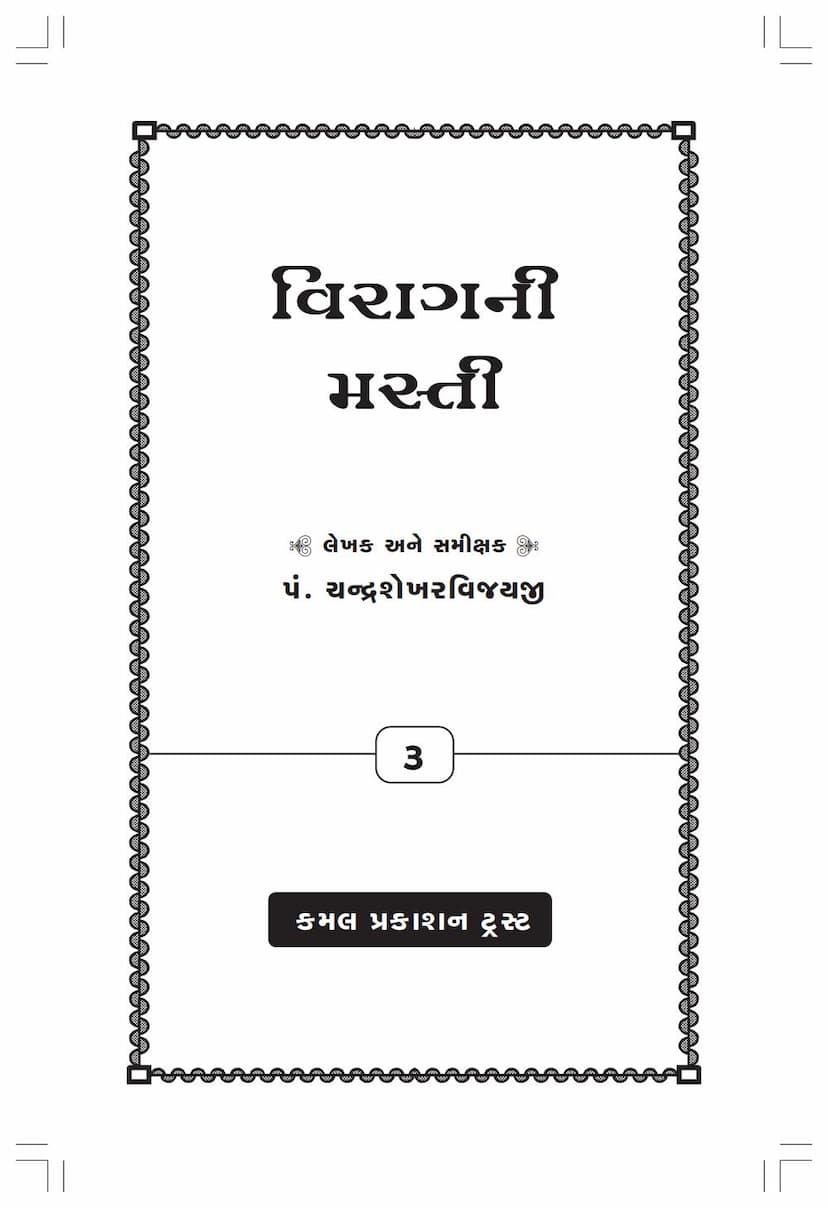Viragni Masti
Added to library: September 2, 2025

Summary
Certainly, here is a comprehensive summary of the Jain text "Viragni Masti" by Chandrashekharvijay, based on the provided pages:
Book Title: Viragni Masti Author: Pt. Chandrashekharvijayji Publisher: Kamal Prakashan Trust
"Viragni Masti" (The Bliss of Detachment) is a profound Jain text that explores the spiritual journey and the essence of detachment, written by Pt. Chandrashekharvijayji and published by Kamal Prakashan Trust. The book delves into the modern human condition, the superficiality of materialistic pursuits, and the ultimate path to true happiness through detachment and self-realization, as understood within the Jain philosophy.
Core Themes and Arguments:
The book, through its introductory preface and subsequent chapters, presents a critique of modern society's obsession with material progress, scientific advancement, and superficial pleasures. It contrasts this with the Jain ideal of a life centered on spiritual growth, inner peace, and detachment from worldly possessions and desires.
1. Critique of Modern Materialism: The text argues that modern society, in its relentless pursuit of scientific achievements and material comforts, has become increasingly estranged from its spiritual roots. Humans are depicted as becoming slaves to technology and superficial desires, leading to a loss of inner peace, ethical values, and a sense of purpose. The author laments the artificial adornment of life, the pursuit of fleeting pleasures, and the resulting premature aging and spiritual emptiness.
2. The Ideal of Detachment (Viraga): The central theme of "Viragni Masti" is the concept of detachment, referred to as "Viraga" and the "Masti" (bliss or intoxication) derived from it. The book posits that true happiness and liberation are found not in acquiring possessions but in letting go of them. It equates detachment from the material world with gaining true wealth:
- Detachment from sensual pleasures (like beauty) leads to true beauty.
- Detachment from food (through fasting) leads to increased life-force.
- Detachment from wealth leads to spiritual richness (Dharma).
- Detachment from the world leads to the realization of the soul (Atma).
3. The Path of the Ascetic (Sadhu): The text highlights the role of the ascetic (Sadhu) as a guide on the path of detachment. The Sadhu's life is portrayed as a pilgrimage from the gross to the subtle, and finally to the "void" (Shunya) – a state of pure consciousness and bliss. This spiritual journey involves the art of letting go, living a simple and natural life, and allowing oneself to flow with the natural rhythm of spiritual evolution.
4. The Meaning of True "Masti": The author distinguishes between worldly "masti" (fun, enjoyment) and the spiritual "masti" found in detachment. While the world seeks "masti" in external achievements and sensory experiences, the Sadhu finds it in the inner stillness and joy of self-realization. This inner bliss is described as a state beyond "having" or "letting go," a pure existence of consciousness and bliss.
5. The Importance of Inner Values: The book criticizes the modern emphasis on external appearances, material possessions, and superficial knowledge. It argues that true fulfillment comes from cultivating inner qualities like truthfulness, self-control, discipline, and honesty, which were the traditional Indian ethical values. The erosion of these values in the name of progress has led to a spiritual crisis, characterized by aimlessness and a sense of meaninglessness.
6. The Tale of Suvarnagarh Village: A significant portion of the book is dedicated to a narrative set in the village of Suvarnagarh. This village, despite its name suggesting grandeur, is portrayed as a simple, traditional place. Two pivotal characters represent different aspects of societal contribution:
- Vimal Seth: A wealthy merchant known for his exceptional philanthropy, humility, and deep compassion for the poor. He embodies selfless service and detachment from his wealth, valuing the well-being of others above his own comfort.
- Jivarambhai (Da): An elderly, wise scholar and former government servant who has retired to the village. He dedicates his life to spiritual discourse, moral guidance, and the intellectual upliftment of the villagers. He is shown engaging in deep philosophical discussions, often resolving complex theological and existential questions.
7. Conflict Between Tradition and Modernity: The narrative in Suvarnagarh vividly illustrates the clash between traditional values and the encroaching tide of Westernized modernity. The village youth, influenced by Jivarambhai's teachings, vehemently reject the superficial progress and ethical compromises of modern urban life, including the perceived moral degradation promoted by Western media and education. They champion the simple, virtuous, and self-sufficient lifestyle of the village.
8. The Role of Philosophy and Understanding: Jivarambhai's personal philosophical quest is detailed, as he grapples with conflicting philosophical viewpoints on the nature of the soul (Atma) from various Indian traditions (Vedanta, Buddhism, etc.). He finds resolution in the Jain philosophy, particularly its concepts of Syadvada (the doctrine of manifold predicaments) and Nayavada (the theory of viewpoints), which allow for multiple perspectives on reality without resorting to rigid dogmatism. This journey highlights the importance of intellectual inquiry and the search for truth.
9. The Transformation Through "Viragni Masti": The book concludes by emphasizing the profound impact of understanding and embracing detachment. The characters, particularly the villagers inspired by Jivarambhai's teachings, find true happiness and peace not in material possessions or external validation but in their inner spiritual strength and detachment. Vimal Seth's passing serves as a catalyst for deeper contemplation on the transient nature of life and the importance of spiritual values. Jivarambhai's own departure, described as a voluntary transcendence, further underscores the ultimate goal of spiritual liberation.
Overall Message:
"Viragni Masti" is a call to re-evaluate our priorities in life, urging readers to move away from the superficial allure of materialism and towards the enduring bliss of detachment and self-knowledge. It advocates for a life guided by ethical principles, compassion, and spiritual wisdom, emphasizing that true "masti" lies not in worldly pleasures but in the serene joy of the liberated soul. The book serves as a guide for individuals seeking meaning, peace, and ultimate happiness through the Jain path of detachment and spiritual realization.